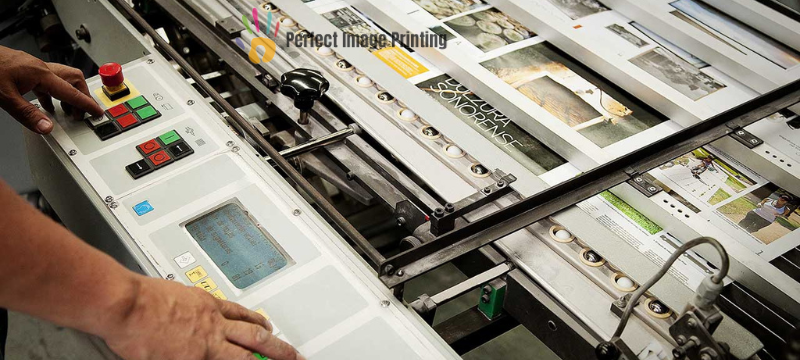What Is Commercial Printing?
Commercial printing refers to the large-scale production of printed materials for businesses, organizations, and individuals. It encompasses a wide range of products, from marketing collateral to labels, packaging, signage, and more. Unlike digital or home printing, commercial printing is designed for high-volume, high-quality output using specialized equipment and techniques.
Types of Commercial Printing
Commercial printing covers a vast array of products and services, tailored to meet the diverse needs of businesses and individuals.
Here are some common types of commercial printing:
Offset Printing
Offset printing, also known as lithography, is a widely used method that involves transferring ink from a plate to a rubber blanket, and then onto the printing surface. It’s known for its high-quality, consistent results, making it suitable for items like brochures, magazines, and posters.
Digital Printing
Digital printing is a modern, cost-effective method that eliminates the need for plates and is ideal for small to medium print runs. It’s commonly used for personalized items like business cards, flyers, and variable data printing.
Large Format Printing
Large-format printing is used for producing oversized materials such as banners, posters, wall graphics, and vehicle wraps. It’s an excellent choice for visually striking and attention-grabbing displays.
Screen Printing
Screen printing involves applying ink through a mesh screen onto various surfaces, including textiles, paper, and plastics. It’s often used for custom apparel, promotional items, and packaging.
Flexographic Printing
Flexographic printing employs flexible relief plates to transfer ink onto materials, making it suitable for packaging, labels, and corrugated cardboard.
Gravure Printing
Gravure printing uses engraved cylinders to produce high-quality, long-run prints. It’s commonly used for magazines, catalogs, and packaging with intricate designs.
Letterpress Printing
Letterpress printing involves pressing inked metal types or plates onto paper, creating a distinct and classic look. It’s favored for premium business cards, invitations, and specialty items.
3D Printing
3D printing is an emerging technology that produces three-dimensional objects by layering material. While not traditional printing, it’s revolutionizing industries like manufacturing, prototyping, and healthcare.
Commercial Printing Process
The commercial printing process is a multi-step journey that transforms digital files into physical printed materials. While specific details can vary depending on the printing method, here’s a general overview:
1. Prepress
This initial stage involves preparing digital files for printing. It includes tasks such as color correction, image resizing, and creating printing plates or screens.
2. Printing Setup
Printing plates or cylinders are created from digital files for offset or flexographic printing. These plates or cylinders are then mounted onto the printing press.
3. Printing
The actual printing process occurs during this stage. Using the prepared plates, screens, or cylinders, the printing press transfers ink onto the chosen substrate (paper, cardstock, fabric, etc.).
4. Quality Control
Printed materials are carefully inspected for defects or imperfections. Any errors are addressed, ensuring the final product meets quality standards.
5. Finishing
Depending on the project’s specific requirements, post-printing processes may include cutting, folding, binding, laminating, or coating.
6. Packaging and Distribution
Once completed, the printed materials are packaged and prepared for distribution. This can involve bulk shipments to a client’s location, direct mailing, or other delivery methods.
Final Word
Commercial printing is a dynamic and essential industry that bridges the gap between the digital and physical worlds. Its wide range of printing methods, meticulous processes, and numerous benefits make it an invaluable resource for businesses looking to create impactful and memorable printed materials. Whether promoting a product, sharing information, or expressing creativity, commercial printing transforms your vision into a tangible reality.
Perfect Image Printers excels in commercial printing, offering unparalleled services to meet your business needs. With a commitment to precision and efficiency, we elevate your brand’s visual communication through top-tier printing solutions.
FAQs
What is the most common commercial printing?
The most common commercial printing method is Offset Printing. Offset printing, known as lithography, is widely used for commercial printing projects. It’s favored for its versatility, high quality, and cost-effectiveness, making it suitable for various applications. Offset printing is often used for projects such as brochures, magazines, catalogs, posters, business cards, stationery, and packaging.
What is the typical turnaround time for a commercial printing project?
Turnaround times can vary depending on the project’s complexity, the printing method used, and the quantity of materials produced. Simple projects like business cards or flyers may have a quicker turnaround, while complex projects like magazines or packaging may take longer. It’s best to discuss specific timelines with your commercial printer.
How do I choose the right printing method for my project?
The choice of printing method depends on factors like the type of material, desired quality, quantity, and budget. Digital printing is ideal for small runs and variable data, while offset printing is cost-effective for larger quantities. Discuss your project’s requirements with your printer to determine the best method.
What is the difference between CMYK and Pantone color printing?
CMYK (Cyan, Magenta, Yellow, Key/Black) is a standard color model used in full-color printing, while Pantone (PMS) is a system of standardized colors used for precise color matching. CMYK suits most projects, but Pantone colors are often used when exact color accuracy is critical, such as for branding materials.
What steps can I take to ensure the best print quality for my project?
To achieve the best print quality, make sure your digital files are high-resolution, use the correct color profiles (CMYK for full color, Pantone for specific colors), and follow any guidelines your printer provides. Review proofs carefully before production approval to catch any errors or issues.





Leave A Comment